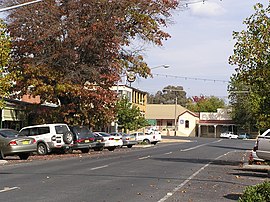Tumbarumba
|
Tumbarumba New South Wales |
|
|---|---|

The Parade, Main street of Tumbarumba
|
|
| Coordinates | 35°47′0″S 148°01′0″E / 35.78333°S 148.01667°ECoordinates: 35°47′0″S 148°01′0″E / 35.78333°S 148.01667°E |
| Population | 1,487 (2006 census) |
| Established | 1850s |
| Postcode(s) | 2653 |
| Elevation | 645 m (2,116 ft) |
| Location |
|
| LGA(s) | Snowy Valleys Council |
| County | Selwyn |
| State electorate(s) | Albury |
| Federal Division(s) | Eden-Monaro |
Tumbarumba (/tʌmbəˈrʌmbə/tum-bə-RUM-bə) is a small town in New South Wales, Australia, about 480 kilometres (300 mi) southwest of the state capital, Sydney. Tumbarumba is located on the periphery of the Riverina and South West Slopes regions at the western edge of the Snowy Mountains. The 2011 census showed the population of the town to 1455 people, a decline from 1,487 people living there in 2006. Locals refer to the town as 'Tumba'.
To the south and east, the highest peak of the Snowy Mountains and mainland Australia—Mount Kosciuszko—can be seen.
The community was established in the late 1850s after gold was discovered in the district. The Post Office opened on 1 August 1860 but was spelt Tumberumba until 1915.
A railway branch line was opened to Tumbarumba in 1921. The Tumbarumba railway line ran from Wagga Wagga through Tarcutta. The service has been suspended since 1987.
Gold mining petered out in the 1930s, and the region's economy now depends on agriculture and tourism. The timber industry dominates the Shire’s economy.
The name Tumbarumba may be derived from Wiradjuri dhamba dhamba, meaning "very soft" or alternatively from the Aboriginal words for "hollow sounding ground", "thunder", "sound" or "place of big trees".
The major industry in the town is softwood timber processing, with the Hyne and Sons Timber Mill to the west of the town being the biggest employer. Other industries include tourism, viticulture (Tumbarumba is in the Tumbarumba wine region), and blueberry growing. Tourism is a source of income due to its proximity to the snow fields.
...
Wikipedia

